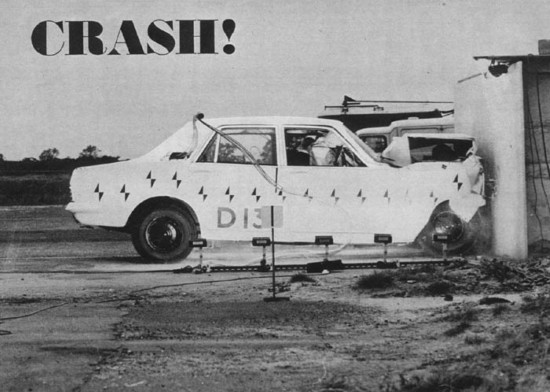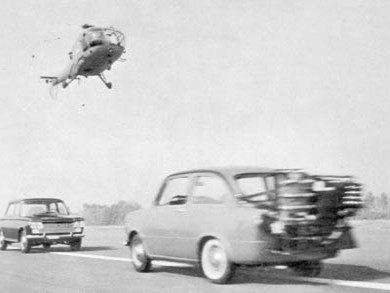NEVER has there been so much smashing and bashing. Test tracks from Detroit to Dagenham;
from Turin to Tokyo resound with the nasty thud of tortured metal as dozens of
cars laden with dummy passengers are deliber-ately crashed in front of high-speed
cameras in experiments designed to find ways to make motoring safer. Some of the American proving grounds I have visited this year were so littered with wrecks that they looked like scrap yards Of course, it isn't new. General Motors were deliberately crashing cars more than thirty years ago; roiling them over, hurtling them into solid objects and wrecking them in cross-roads collisions. From this kind of work the American car emerged with an all-steel "turret top" at a time when occupants of European cars had nothing but wood and fabric to protect them in a roll-over. Now the heat is on and in all the major car manufacturing countries cars are being projected into contrived crashes, carrying thousands of pounds' worth of dummy passengers stuffed with electronic gadgets to record everything that happens to them. What does it all prove? So far, one awkward fact has emerged. The designer needs to know whether the occupants are going to wear safety belts or not, because protection for belt wearers and conscientious objectors requires two different kinds of car. There's a lot of talk about "controlled crumpling" the idea being that the front structure slows down the car progressively, but even with a long bonnet, it's all over in a tiny fraction of a second and without seat belts the occupants are still moving forward at full speed after it has stopped. It's when they smash inside of the car that the injuries start. With safety harness done up tight, the car, plus the stretch in the harness slows the occupants. progressively and provided there is 17" of clearance in front of head, chest and knees, there is a good chance of walking away from the crash. Cold Courage Cot Stapp of the United States Air Force blazed the trail with cold courage to find out just what the human body wilt stand under these conditions. He had himself propelled across the desert on a rocket-driven sled which was slowed from154 to 34mph in 3lft. His body hit the harness with the force of four tons, e his eyes bulged and his face was contorted but he triumphantly demonstrated that the human body properly supported car. Withstand a force of 46.2G. This means that he could walk away unhurt from a car which had hit a tree at 60 mph. and come to a stop in 3ft. Of course, it also means that the passenger compartment must be made as strong as possible. Once that crumples the safety belt can't help. If no belts are to be worn the designer needs to make the car as close fitting as possible with thick pads to protect the head, chest and knees; especially the head. because anything up to 75 per cent of road deaths are caused by head injuries. Glove boxes, shin breaking parcel shelves and all projecting knobs or switches must be eliminated, both in front of the driver and above his head. But even padding a foot thick won't give protection comparable with safety harness. The steering column must be made to collapse or deflect away from the driver but if you rely on the steering wheel to stop the driver the load on his chest is going to be at least twice that which he would suffer with a safety harness. Every detail matters. it has been known for a steering column to move obligingly out of the way only to let the driver cut his throat on a sharp visor over the instruments. Laminated glass causes far more injuries than toughened glass and when the head goes through laminated glass the lacerations are horrible. Many people fear the sudden loss of vision when a toughened screen crazes over but researchers have not so far been able to establish that this causes any significant number of bad accidents and research is going on to produce particle patterns which will maintain adequate vision without increasing injuries from flying pieces. There is still room for improvement in seat anchorages. In particular, British manufacturers go on making tip-up seats without the locks that are compulsory in other countries. Police told me of one sad case where a careful mother fitted a safety harness to hold her small child to the seat. One day she braked hard. The car didn't hit anything but the tip-up seat pushed the baby through the windscreen and killed it. Stopping the People Most of the research work is concentrated on protecting car occupants against impacts at the front of the car, as these represent about 80 per cent of all accidents. but there are other kinds. If the car is hit in the rear through a shunt or a skid, the luggage boot will crumple as an effective shock absorber and even with a rear engine the passenger compartment may be saved from damage - but you still have to stop the people. After a rear-end impact people have been found sitting in the car belted and unmarked but dead-from a broken neck. The chin will prevent the head breaking the neck in a frontal impact but there is nothing to protect the neck from the whiplash effect or a rearward impact except a headrest or a high backrest. Side impacts, such as a cross-road accident or a skid into a tree or lamp-post are difficult to cope with. There is no room for controlled crumpling or lots of padding Several safety cars have been designed with sliding doors which are a good protection against injuries to pedestrians, cyclists and motor cyclists from doors that are carelessly opened. but I wouldn't give much for the chance of getting the occupants out quickly after a sideways impact had crumpled all the runners and levers of a sliding door. Warning of Wear Of course, we all hope to avoid the accident and European cars give you more help than the Americans in this respect. They have quicker, more responsive steering and better road holding: thanks to British pioneer work they have better brakes with higher fade resistance. They have better tyres with higher cornering power and a stronger grip in the wet and European designers have produced a whole variety of anti-locking devices, the most advanced being the Citroen system which automatically proportions the braking effort according to the load and the Dunlop Maxarct on the Jensen FF which make brake locking impossible. Reminder lights for handbrakes are quite common and now we are beginning to see warning lights to show when the pads of disc brakes need renewing. Citroen started it and now they are on the Renault 16. But the pressure is on in the United States and things are moving fast, with a big switch to disc brakes at least on the front in the 1967 models and the general adoption of dual master cylinders which are still fairly rare in Europe although Sweden has almost 100 per cent coverage since both Saab and Volvo adopted them. It means that no single hydraulic fault can put the whole braking system out of action; you still have at least two brakes working. The Americans are also pushing ahead with the "four-way hazard warning," a switch which will set all four direction indicators flashing simultaneously to warn other traffic if the car is immobilised on a busy road. Safety has become a top-selling feature and at the British industry's MIRA research establishment the two top subjects are increased safety and reduced air pollution. But however safe the cars, they still have to operate on British roads, the most overcrowded in the world. The present Government's contribution has been to slow down the road programme while pushing motor vehicle taxes up to the unheard-of total of £1200,000 a year. In these circumstances it was a fair piece of impertinence for Auntie Castle to lecture car manufacturers about the need to sell safety. What we need from the Government is not lectures and restrictions, but practical measures like safety barriers down the middle of the motorways, such as they have in Germany and U.S.A. and are now installing in Italy. Local authorities should be obliged to use lightweight lamp-posts which can be knocked down without killing people, and we need firmer control over the local surveyors who litter the roads with lethal obstructions like islands and badly designed roundabouts. I could even show Mrs. Castle a place where a massive wall has been built to protect a tree, right on the edge of a new dual carriageway. A lot of people may be killed and injured in vehicles that hit the wall, but the tree will be O.K. |
Why this picture is important to every driver, everywhere
By Gordon Wilkins |

Crunch-point for the Zephyr MkIV. Cameras freeze the action as head lamps shatter, the engine compartment crumples,
and the unrestrained dummy driver catapults into the steering wheel. Only one tenth of a second ago the car was intact. The doors remain closed, and the bonded windscreen stays in place, the passenger compartment remains intact. Occupants wearing properly designed seat belts would have walked away from the crash unhurt. |
Article courtesy Daily Express 1966 Motor Show Review |
Mk IV Pages |

Secura, a safety car produced by engineers of Italian motor magazine Quattroruote in collaboration with OSI, the body builders. It features front and rear ends capable of controlled cumpling, sliding doors, elimination of all exterior projections likely to damage pedestrians, and thickly padded interior. Unlike Sigma, it has an engine and can run on the road. |

Fiat stage a head - on crash between a Fiat 1500 and a Fiat 850 to assess their safety
factors. The cars, loaded with recording equipment, are controlled by radio from the hovering helicopter. |

Worldwide discussion was provoked by the Pininfarina Sigma safety car, with crushable
front and rear ends and an extra strong passenger compartment with reinforced
floor to keep the engine out in a crash. The interior is heavily padded, the steering wheel is collapsible, and all seats have headrests. But how do you get out if the runners of the sliding door are jammed by a sideways impact? |